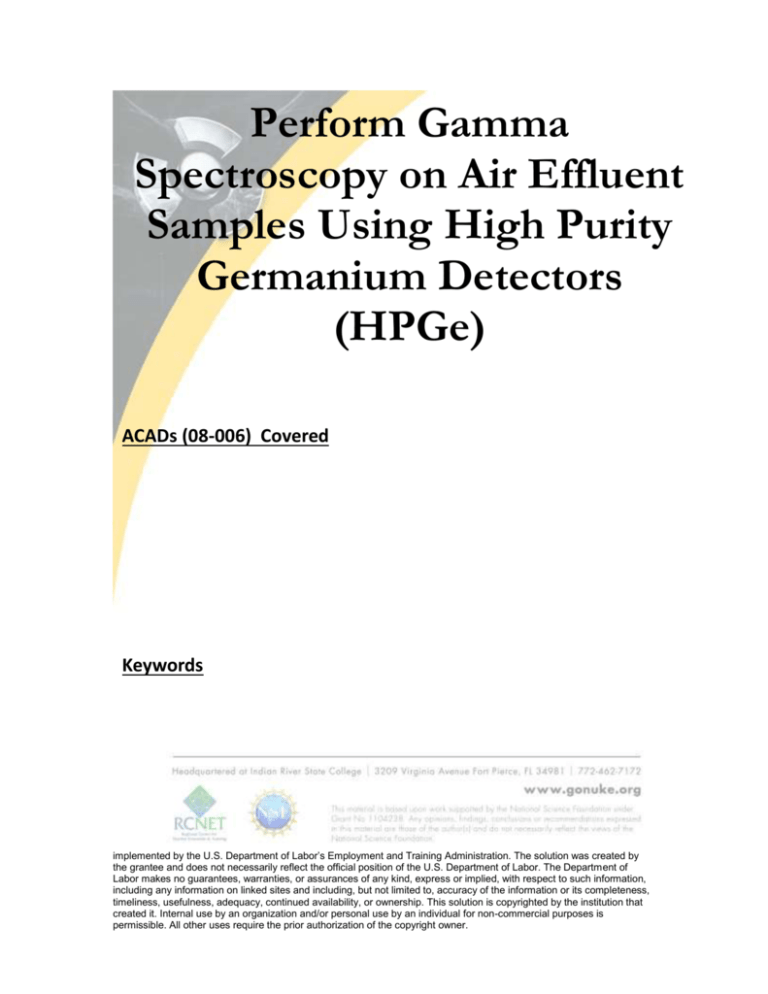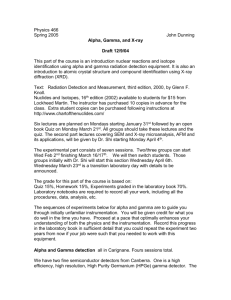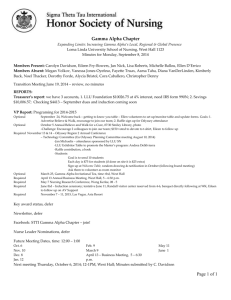
Perform Gamma
Spectroscopy on Air Effluent
Samples Using High Purity
Germanium Detectors
(HPGe)
ACADs (08-006) Covered
Keywords
Description
Copyright © 2008-2009 - Curators of the University of Missouri, in collaboration with Linn
State Technical College. All rights reserved. DMCA and other copyright information.
Supporting Material
This workforce solution was funded by a grant awarded under the President’s High-Growth Job Training Grants as
implemented by the U.S. Department of Labor’s Employment and Training Administration. The solution was created by
the grantee and does not necessarily reflect the official position of the U.S. Department of Labor. The Department of
Labor makes no guarantees, warranties, or assurances of any kind, express or implied, with respect to such information,
including any information on linked sites and including, but not limited to, accuracy of the information or its completeness,
timeliness, usefulness, adequacy, continued availability, or ownership. This solution is copyrighted by the institution that
created it. Internal use by an organization and/or personal use by an individual for non-commercial purposes is
permissible. All other uses require the prior authorization of the copyright owner.
RPT 113
Instructional Resources
Module Perform Gamma Spectroscopy on Air Effluent Samples Using High Purity Germanium
Detectors (HPGe)
The Curators of the University of Missouri
Copyright © 2008-2009
A Product of DOL Grant # HG-15355-06-60
Page 1
RPT 113
Instructional Resources
Module 9: Perform Gamma Spectroscopy on Air Effluent
Samples Using High Purity Germanium Detectors
(HPGe)
Table of Contents:
Note to Instructors: ............................................................................................................. 3
Resources Key .................................................................................................................... 3
Module Readings and Homework ...................................................................................... 3
Primary Scenario “Analyze Air Monitor Particulate Filter for Gamma Emitting
Isotopes” ......................................................................................................................... 3
Transfer Scenario “Analyze Charcoal Filter for Gamma Emitting Isotopes” ................ 4
Module Assessment Items .................................................................................................. 5
Primary Scenario “Analyze Air Monitor Particulate Filter for Gamma Emitting
Isotopes” ......................................................................................................................... 5
Suggested Labs ................................................................................................................... 6
ACAD References .............................................................................................................. 7
RPT 113 Instructor’s Guide
The Curators of the University of Missouri
Copyright © 2008-2009
A Product of DOL Grant # HG-15355-06-60
Page 2
RPT 113
Instructional Resources
Note to Instructors:
This primary module contains two primary concepts – Gamma-Ray Spectroscopy (using HPGe
detectors and MCAs) and Counting Statistics (the statistics of radiation counting and the principle
of LLD). As such, this module will probably require two weeks and it is recommended that these
two primary concepts be treated separately within the context of this scenario. There are also
numerous labs that could be considered that relate to both concepts.
Resources Key
This refers This reference:
to:
ACAD
National Academy for Nuclear Training, Uniform Curriculum Guide for
Nuclear Power Plant Technician, Maintenance, and Nonlicensed
Operations Personnel Associate Degree Programs, ACAD 08-006.
DOE-SG
Office of Environmental, Safety and Health: Radiological Control
Technician Training Site Academic Training Study Guide Phase I,
Project Number TRNG-0003
G.
Spectrum
Supl. Lab
Available at: http://nsedu.rnet.missouri.edu/docshare/. File is located
under the Docs/General Curriculum/DOE materials folder.
Gollnick, D. (2006). Basic Radiation Protection Technology, 5th Ed.
Pacific Radiation Corporation, Altadena, CA.
Spectrum Spectroscopy Techniques Lab Manual (Instructors and
Student Versions)
Supplemental Lab Manual (instructors and Student Versions)
Module Readings and Homework
Primary Scenario “Analyze Air Monitor Particulate Filter for
Gamma Emitting Isotopes”
Core Concept: High purity germanium (HPGe) spectrometers for gamma-ray spectroscopy
Homework (end of chapter)
Readings
Calculation Items
Non-calculation Items
G., Chap. 7, 284-290
N/A
G., Chap. 7, # 29
DOE SG 1.13-30 to 1.13-35
DOE SG 2.19.9 to 2.19-10
DOE SG 2.19-13 to 2.19-15
DOE SG 1.13-11
Module Perform Gamma Spectroscopy on Air Effluent Samples Using High Purity Germanium
Detectors (HPGe)
The Curators of the University of Missouri
Copyright © 2008-2009
A Product of DOL Grant # HG-15355-06-60
Page 3
RPT 113
Instructional Resources
Core Concept: Multichannel Analyzers (MCAs) and gamma-ray spectra
Homework (end of chapter)
Readings
Calculation Items
Non-calculation Items
G., Chap. 7, 278-280
N/A
G., Chap. 7, # 13
Core Concept: Statistics of radiation counting
Homework (end of chapter)
Readings
Calculation Items
Non-calculation Items
G., Chap.12, # 528-535
G., Chap.12, # 25, 26, 27, 28, G., Chap.12, # 24
31
DOE SG 2.03-1 to 2.03-14
DOE SG 2.03.01 to
DOE SG 2.03.04
2.03.03
DOE SG 2.03.06
DOE SG 2.03.05
DOE SG 2.03.13
DOE SG 2.03.07 to
2.03.12
Core Concept: Lower Limits of Detection (LLD)
Homework (end of chapter)
Readings
Calculation Items
Non-calculation Items
G., Chap. 12, 235-237
DOE SG 2.03-22
G., Chap.12, # 29, 30
DOE SG 2.03-28 to 31
DOE SG 2.03-21
Transfer Scenario “Analyze Charcoal Filter for Gamma Emitting
Isotopes”
Refer to readings and homework for primary scenario above.
RPT 113 Instructor’s Guide
The Curators of the University of Missouri
Copyright © 2008-2009
A Product of DOL Grant # HG-15355-06-60
Page 4
RPT 113
Instructional Resources
Module Assessment Items
Note: If instructors wish to increase the difficulty of any item, then we suggest
you use it as the basis for an in-class discussion, and / or require students to
write an explanation for why a particular choice is correct.
Primary Scenario “Analyze Air Monitor Particulate Filter for
Gamma Emitting Isotopes”
You are a Radiation Protection Technician at a commercial research reactor facility. You have
been assigned to change the particulate filter on the operating effluent stack monitor and analyze
it for gamma-emitting isotopes. The stack monitors continuously sample the ventilation exhaust of
the facility. You have just obtained the particulate sample filter and are proceeding to analyze it
on the High Purity Germanium (HPGe) Detector System. You have performed this analysis many
times and are following a procedure to ensure that you always do it the same way and do not
miss any steps.
1. (Inference) After performing a 20-minute count of the sample with the HPGe detector
system, you notice that there is no liquid nitrogen in the detector dewar. What likely
impact will this have on the accuracy of the detector counts you have obtained?
A.) The counts will be lower than actual sample counts.
B.) The counts will be higher than actual sample counts. (correct)
C.) The sample isotope energy peaks will be lower than they should be.
D.) The sample isotope energy peaks will be higher than they should be.
2. (Inference) Which reason best explains your answer to Question 1?
A.) More electron-hole pairs will form in the HPGe crystal. (correct)
B.) Less electron-hole pairs will form in the HPGe crystal.
C.) Each gamma ray interaction will produce less electron-hole pairs.
D.) Each gamma ray interaction will produce more electron-hole pairs.
3. (Explanation) Which explanation below best describes how a multi-channel analyzer
(MCA) identifies a particular gamma-emitting isotope?
A.) It uses a calibration standard to identify an isotope.
B.) It uses an algorithm in the circuitry to identify an isotope.
C.) It uses a data file of gamma energies to identify an isotope. (correct)
D.) It doesn’t identify an isotope, this is a manual process.
4. (Prediction) What impact will decreasing the background counts have on the lower
level of detection (LLD)?
A.) It will lower the LLD. (correct)
B.) It will raise the LLD.
C.) It will decrease the accuracy of the LLD.
D.) It will have no effect on the LLD
5. (Prediction) Which of the following actions will decrease the statistical validity of
sample counts?
A.) Adding more shielding around the detector
B.) Increasing the efficiency of the detector
C.) Moving the sample farther away from the detector (correct)
D.) Counting the sample for a longer period of time
Module Perform Gamma Spectroscopy on Air Effluent Samples Using High Purity Germanium
Detectors (HPGe)
The Curators of the University of Missouri
Copyright © 2008-2009
A Product of DOL Grant # HG-15355-06-60
Page 5
RPT 113
Instructional Resources
Suggested Labs
For counting statistics:
Spectrum, Lab # 2: Statistics of Counting, page 19.
For gamma-ray spectroscopy: Select any or all of the following from the Spectrum manual:
Spectrum Lab 1, page. 7 – Energy Calibration
Spectrum Lab 2, page. 10 – Gamma Spectra
Spectrum Lab 3, page.12 – Detector Resolution
Spectrum Lab 11.2, page. 34 – Potassium in Fertilizer
Spectrum Lab 14.1, page. 45 – Gamma Spectra from Air Samples
Lab Notes:
1) The above list represents more labs than can likely be covered in a two week period; thus
some subset may be appropriate. For example, Lab 1 – Energy Calibration could be
completed by the instructor prior to having the class use the systems, explaining what
has been done, and proceeding with the next lab. Spectrum Lab 11.2 is also optional.
2) Spectrum Labs should be used in the order outlined above.
3) Although this module is for HPGe detector systems, the principles can be learned from
the lower energy resolution NaI spectra measured in these labs. The Detector
Resolution lab can be used to explain the differences between HPGe and NaI.
RPT 113 Instructor’s Guide
The Curators of the University of Missouri
Copyright © 2008-2009
A Product of DOL Grant # HG-15355-06-60
Page 6
RPT 113
Instructional Resources
ACAD References
ACAD
3.2.2 RADIATION DETECTION AND MEASUREMENT PRINCIPALS
Explain the function of a scintillation (micro-r meters, liquid scintillation
counters, zinc-sulfide alpha counters and probes), fission chamber and
semiconductors (high-purity germanium, electronic dosimeters) *
3.2.3 RADIOLOGICAL SURVEY AND ANALYSIS INSTRUMENTS
Describe the statistical nature of radioactive decay as it relates to
uncertainties encountered when measuring radioactivity (such as
normal distribution curves, standard deviations, confidence levels,
lower limits of detection and minimum detectable activity)
Explain the operating characteristics and use of the following
radiological survey and analysis instruments:
– Multichannel analyzer (gamma spectrometer)
3.2.5 CALIBRATION SOURCE AND EQUIPMENT
Discuss the type of equipment required to calibrate counting and
spectroscopy equipment.
Identify the criteria for proper calibration of counting and spectroscopy
equipment.
*ACAD is also referenced in other courses of the curriculum
Module Perform Gamma Spectroscopy on Air Effluent Samples Using High Purity Germanium
Detectors (HPGe)
The Curators of the University of Missouri
Copyright © 2008-2009
A Product of DOL Grant # HG-15355-06-60
Page 7








